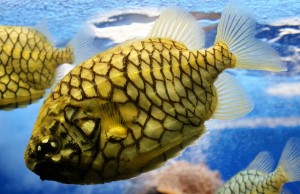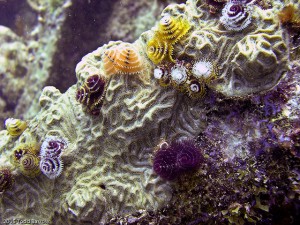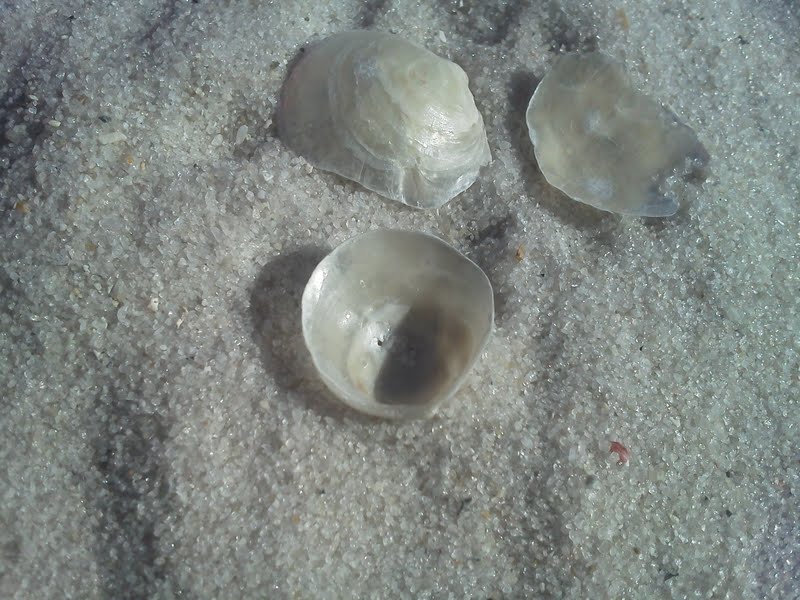Many marine species have festive holiday names. Jingle Shells, Pinecone Fish, Red Drum, Marine Snow, and Christmas Tree Worms are just a few.

Pine Cone Fish – Photo Credit, Flickr user, Spencer Wright
Pinecone Fish get their name as result of their armored plates called scutes. The scutes have ridges which cause the fish to resemble a pinecone. Pinecone fish are native to warm waters of the Indoneasion and Western Pacific Oceans.
Pinecone fish feed on zooplankton which they attract using bioluminescent organs that are found on each side of their lower jaw. The organs form a symbiotic relationship with phosphorescent bacteria that live with the fish. The bioluminescence can be turned on and off by movement of the jaw.
Pinecone fish can be found in areas that have caves, ledges and rocky bottoms.

Christmas Tree Worms – Photo credit: Flickr user Todd Barrow
Christmas Tree Worms are Christmas tree shaped worms that form burrows corals. The tentacles, which form the tree-like structures are used for feeding on plankton and to breathe. These plumed creatures are a type of polychaete worm.
Christmas tree worms come in many colors and can be found all over the world. They feed by using their feathery appendages, called radioles to capture phytoplankton that floats by the “feathers.”
Christmas tree worms are easily disturbed and will quickly vanish into their burrows as shadows or larger marine life pass by. They return quickly and continue with their sedentary lifestyles in the coral.
One of our local favorites, the Red Drum is named as result of the drumming sound with speciliazed muscels that rub against their air bladder. Click here now to hear the sound.
Red drum feed on crabs, shrimp and small fish. They are bottom feeders, and sometime expose their tails to the surface of the water while they feed. This is known as “tailing”.
http://www.youtube.com/watch?v=780x9s9SrRY
Red drum or redfish can be found in shallow waters of bays and bayous. They have characteristic black spots on the tail fin; the number varies on each fish. They are a delicious fish when cooked and put up a good fight when caught.
Marine Snow gets its name as a result of the fluffy materials that resemble snow falling from the sky. Marine snow is decaying material from plants and animals that have died in the oceans. Marine snow may also include sand, fecal matter and inorganic dust.
Just like snowflakes, marine snow grows as it floats to the ocean depths. Marine snow is consumed by scavengers that live along the deep sea floor bottom. Check out the video below showing the beauty of marine snow.
Jingle Shells get their name as a result of their shells that when shaken together make a jingle like sound. Jingle shells can be found along the beaches of NW Florida. The shiny iridescent shell is strong and very attractive. Many shell collectors use the shells to make jewelry and wind chimes.
Jingle shells are bivalves and live attached to hard surfaces, just like oysters.
Jingle shells are filter feeders, meaning water is filtered through their gills for plankton.
References and More Information:
http://www.edc.uri.edu/restoration/html/gallery/invert/jingle.htm
http://en.wikipedia.org/wiki/Monocentridae
http://www.edc.uri.edu/restoration/html/gallery/invert/jingle.htm
http://oceanservice.noaa.gov/facts/marinesnow.html
http://marinebio.org/species.asp?id=543#.UNDa6uT7K8A
- Explore Escribano Point Wildlife Management Area - November 19, 2021
- Team True Blue Provides Shark Data to increase NOAA Research on the Navarre Beach Fishing Pier - March 5, 2021
- Oyster Reef Mapping in the Pensacola Bay System, how is oyster reef mapping done? - January 22, 2021



